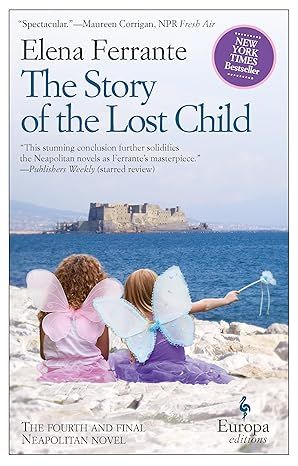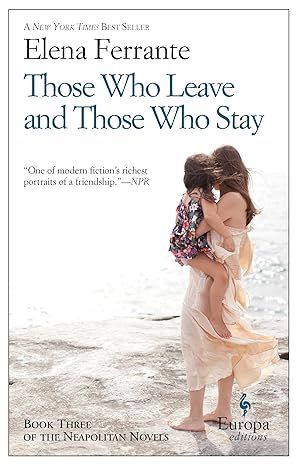My Brilliant Friend
4
-
30,963 ratings
Named the #1 Book of the 21st Century by the New York Times: The “enduring classic” about the lifelong friendship of two women from Naples (The Atlantic).
Beginning in the 1950s in a poor but vibrant neighborhood on the outskirts of Naples, Elena Ferrante’s four-volume story spans almost sixty years, as its main characters, the fiery and unforgettable Lila and the bookish narrator, Elena, become women, wives, mothers, and leaders, all the while maintaining a complex and at times conflicted friendship. This first novel in the series follows Lila and Elena from their fateful meeting as ten-year-olds through their school years and adolescence.
Through the lives of these two women, Ferrante tells the story of a neighborhood, a city, and a country as it is transformed in ways that, in turn, also transform the relationship between two women.
“An intoxicatingly furious portrait of enmeshed friends.” —Entertainment Weekly
“Spectacular.” —Maureen Corrigan, NPR’s Fresh Air
“Captivating.” —The New Yorker
Basis for the HBO series
Kindle
$3.99
Available instantly
Audiobook
$0.00
with membership trial
Hardcover
$30.30
Paperback
$11.62
Ships from
Amazon.com
Payment
Secure transaction
ISBN-10
1787702227
ISBN-13
978-1787702226
Print length
331 pages
Language
English
Publisher
Europa Editions
Publication date
March 04, 2020
Dimensions
7.76 x 0.94 x 5.08 inches
Item weight
2.31 pounds
Popular Highlights in this book
Life was like that, that’s all, we grew up with the duty to make it difficult for others before they made it difficult for us.
Highlighted by 1,754 Kindle readers
But in a confused way I felt that if I ran away with the others I would leave with her something of mine that she would never give back.
Highlighted by 1,274 Kindle readers
The conclusion we drew from this convinced us that it was best to do everything on purpose, deliberately, so that you would know what to expect.
Highlighted by 1,267 Kindle readers
The beauty of mind that Cerullo had from childhood didn’t find an outlet, Greco, and it has all ended up in her face, in her breasts, in her thighs, in her ass, places where it soon fades and it will be as if she had never had it.
Highlighted by 1,192 Kindle readers
When there is no love, not only the life of the people becomes sterile but the life of cities.
Highlighted by 985 Kindle readers
Product details
ASIN :
B085MRYW7D
File size :
5492 KB
Text-to-speech :
Enabled
Screen reader :
Supported
Enhanced typesetting :
Enabled
X-Ray :
Not Enabled
Word wise :
Enabled
Editorial Reviews
#1 BEST BOOK OF THE CENTURY - NEW YORK TIMES
“The book expands as propulsively as the early universe, encompassing ideas about art and politics, class and gender, philosophy and fate, all through a dedicated focus on the conflicted, competitive friendship between Elena and Lila...uncompromising, unforgettable.”—The New York Times, The #1 Best Book of the 21st Century
“A large, captivating, amiably peopled bildungsroman.”—James Wood, The New Yorker
“One of modern fiction’s richest portraits of a friendship.”—John Powers, NPR’s Fresh Air
“Elena Ferrante is one of the great novelists of our time.”—Roxana Robinson, The New York Times Book Review
“Compelling, visceral and immediate…The Neapolitan novels are a tour de force.”—Jennifer Gilmore, The Los Angeles Times
“It took my breath away…so honest and right and opens up heart to so much.”—Elizabeth Strout, writer
“The Neapolitan novel cycle is an unconditional masterpiece.”—Jhumpa Lahiri, writer
“Everyone should read anything with Ferrante’s name on it.”—Eugenia Williamson, The Boston Globe
“Ferrante’s own writing has no limits, is willing to take every thought forward to its most radical conclusion and backwards to its most radical birthing.”—The New Yorker
“One of the more nuanced portraits of feminine friendship in recent memory.”—Megan O’Grady, Vogue
“It’s just hypnotic. I could not stop reading it or thinking about it.”—Hillary Clinton
“Ferrante tackles girlhood and friendship with amazing force.”—Gwyneth Paltrow, actor
“Ferrante’s writing seems to say something that hasn’t been said before in a way so compelling its readers forget where they are, abandon friends and disdain sleep.”—Joanna Biggs, The London Review of Books
“Ferrante has written about female identity with a heft and sharpness unmatched by anyone since Doris Lessing.”—Elizabeth Lowry, The Wall Street Journal
“No one has a voice quite like Ferrante’s. Her gritty, ruthlessly frank novels roar off the page with a barbed fury, like an attack that is also a defense...Imagine if Jane Austen got angry and you’ll have some idea of how explosive these works are.”—John Freeman, writer
"When I read the Neapolitan novels I find that I never want to stop.”—Molly Fischer, The New Yorker
“Dazzling...stunning...an extraordinary epic.”—Michiko Kakutani, The New York Times
“Spectacular.”—Maureen Corrigan, NPR’s Fresh Air
“What words do you save? Here’s your chance to bring them out, like the silver for the wedding of the first-born: genius, tour de force, masterpiece. They apply to the work of Elena Ferrante…her magnificent Neapolitan quartet seems to me to be the greatest achievement in fiction of the post-war era.”—Charles Finch, The Chicago Tribune
“We are dealing with masterpieces here, old-fashioned classics, filled with passion and pathos…The sheer power of her books is a challenge to the chilly, dour craftsmanship of too many 21st century literary novels.”—Joe Klein, TIME Magazine
“The saga is both comfortingly traditional and radically fresh, it gives readers not just what they want, but something more than they didn't know they craved...through this fusion of high and low art, Ms. Ferrante emerges as a 21st-century Dickens.”—The Economist
“Ferrante’s accomplishment in these novels is to extract an enduring masterpiece from dissolving margins, from the commingling of self and other, creator and created, new and old, real and whatever the opposite of real may be…Ferrante’s voice is very much her own, but its force is communal.”—Judith Shulevitz, The Atlantic
“Ferrante adumbrates the mysterious beauty and brutality of personal experience.”—Rachel Cusk, The New York Times Book Review
Read more
Sample
CHILDHOOD
The Story of Don Achille
1.
My friendship with Lila began the day we decided to go up the dark stairs that led, step after step, flight after flight, to the door of Don Achille’s apartment.
I remember the violet light of the courtyard, the smells of a warm spring evening. The mothers were making dinner, it was time to go home, but we delayed, challenging each other, without ever saying a word, testing our courage. For some time, in school and outside of it, that was what we had been doing. Lila would thrust her hand and then her whole arm into the black mouth of a manhole, and I, in turn, immediately did the same, my heart pounding, hoping that the cockroaches wouldn’t run over my skin, that the rats wouldn’t bite me. Lila climbed up to Signora Spagnuolo’s ground-floor window, and, hanging from the iron bar that the clothesline was attached to, swung back and forth, then lowered herself down to the sidewalk, and I immediately did the same, although I was afraid of falling and hurting myself. Lila stuck into her skin the rusted safety pin that she had found on the street somewhere but kept in her pocket like the gift of a fairy godmother; I watched the metal point as it dug a whitish tunnel into her palm, and then, when she pulled it out and handed it to me, I did the same.
At some point she gave me one of her firm looks, eyes narrowed, and headed toward the building where Don Achille lived. I was frozen with fear. Don Achille was the ogre of fairy tales, I was absolutely forbidden to go near him, speak to him, look at him, spy on him, I was to act as if neither he nor his family existed. Regarding him there was, in my house but not only mine, a fear and a hatred whose origin I didn’t know. The way my father talked about him, I imagined a huge man, covered with purple boils, violent in spite of the “don,” which to me suggested a calm authority. He was a being created out of some unidentifiable material, iron, glass, nettles, but alive, alive, the hot breath streaming from his nose and mouth. I thought that if I merely saw him from a distance he would drive something sharp and burning into my eyes. So if I was mad enough to approach the door of his house he would kill me.
I waited to see if Lila would have second thoughts and turn back. I knew what she wanted to do, I had hoped that she would forget about it, but in vain. The street lamps were not yet lighted, nor were the lights on the stairs. From the apartments came irritable voices. To follow Lila I had to leave the bluish light of the courtyard and enter the black of the doorway. When I finally made up my mind, I saw nothing at first, there was only an odor of old junk and DDT. Then I got used to the darkness and found Lila sitting on the first step of the first flight of stairs. She got up and we began to climb.
We kept to the side where the wall was, she two steps ahead, I two steps behind, torn between shortening the distance or letting it increase. I can still feel my shoulder inching along the flaking wall and the idea that the steps were very high, higher than those in the building where I lived. I was trembling. Every footfall, every voice was Don Achille creeping up behind us or coming down toward us with a long knife, the kind used for slicing open a chicken breast. There was an odor of sautéing garlic. Maria, Don Achille’s wife, would put me in the pan of boiling oil, the children would eat me, he would suck my head the way my father did with mullets.
We stopped often, and each time I hoped that Lila would decide to turn back. I was all sweaty, I don’t know about her. Every so often she looked up, but I couldn’t tell at what, all that was visible was the gray areas of the big windows at every landing. Suddenly the lights came on, but they were faint, dusty, leaving broad zones of shadow, full of dangers. We waited to see if it was Don Achille who had turned the switch, but we heard nothing, neither footsteps nor the opening or closing of a door. Then Lila continued on, and I followed.
She thought that what we were doing was just and necessary; I had forgotten every good reason, and certainly was there only because she was. We climbed slowly toward the greatest of our terrors of that time, we went to expose ourselves to fear and interrogate it.
At the fourth flight Lila did something unexpected. She stopped to wait for me, and when I reached her she gave me her hand. This gesture changed everything between us forever.
2.
It was her fault. Not too long before—ten days, a month, who can say, we knew nothing about time, in those days—she had treacherously taken my doll and thrown her down into a cellar. Now we were climbing toward fear; then we had felt obliged to descend, quickly, into the unknown. Up or down, it seemed to us that we were always going toward something terrible that had existed before us yet had always been waiting for us, just for us. When you haven’t been in the world long, it’s hard to comprehend what disasters are at the origin of a sense of disaster: maybe you don’t even feel the need to. Adults, waiting for tomorrow, move in a present behind which is yesterday or the day before yesterday or at most last week: they don’t want to think about the rest. Children don’t know the meaning of yesterday, of the day before yesterday, or even of tomorrow, everything is this, now: the street is this, the doorway is this, the stairs are this, this is Mamma, this is Papa, this is the day, this the night. I was small and really my doll knew more than I did. I talked to her, she talked to me. She had a plastic face and plastic hair and plastic eyes. She wore a blue dress that my mother had made for her in a rare moment of happiness, and she was beautiful. Lila’s doll, on the other hand, had a cloth body of a yellowish color, filled with sawdust, and she seemed to me ugly and grimy. The two spied on each other, they sized each other up, they were ready to flee into our arms if a storm burst, if there was thunder, if someone bigger and stronger, with sharp teeth, wanted to snatch them away.
We played in the courtyard but as if we weren’t playing together. Lila sat on the ground, on one side of a small barred basement window, I on the other. We liked that place, especially because behind the bars was a metal grating and, against the grating, on the cement ledge between the bars, we could arrange the things that belonged to Tina, my doll, and those of Nu, Lila’s doll. There we put rocks, bottle tops, little flowers, nails, splinters of glass. I overheard what Lila said to Nu and repeated it in a low voice to Tina, slightly modified. If she took a bottle top and put it on her doll’s head, like a hat, I said to mine, in dialect, Tina, put on your queen’s crown or you’ll catch cold. If Nu played hopscotch in Lila’s arms, I soon afterward made Tina do the same. Still, it never happened that we decided on a game and began playing together. Even that place we chose without explicit agreement. Lila sat down there, and I strolled around, pretending to go somewhere else. Then, as if I’d given it no thought, I, too, settled next to the cellar window, but on the opposite side.
The thing that attracted us most was the cold air that came from the cellar, a breath that refreshed us in spring and summer. And then we liked the bars with their spiderwebs, the darkness, and the tight mesh of the grating that, reddish with rust, curled up both on my side and on Lila’s, creating two parallel holes through which we could drop rocks into obscurity and hear the sound when they hit bottom. It was all beautiful and frightening then. Through those openings the darkness might suddenly seize the dolls, who sometimes were safe in our arms, but more often were placed deliberately next to the twisted grating and thus exposed to the cellar’s cold breath, to its threatening noises, rustling, squeaking, scraping.
Nu and Tina weren’t happy. The terrors that we tasted every day were theirs. We didn’t trust the light on the stones, on the buildings, on the scrubland beyond the neighborhood, on the people inside and outside their houses. We imagined the dark corners, the feelings repressed but always close to exploding. And to those shadowy mouths, the caverns that opened beyond them under the buildings, we attributed everything that frightened us in the light of day. Don Achille, for example, was not only in his apartment on the top floor but also down below, a spider among spiders, a rat among rats, a shape that assumed all shapes. I imagined him with his mouth open because of his long animal fangs, his body of glazed stone and poisonous grasses, always ready to pick up in an enormous black bag anything we dropped through the torn corners of the grate. That bag was a fundamental feature of Don Achille, he always had it, even at home, and into it he put material both living and dead.
Lila knew that I had that fear, my doll talked about it out loud. And so, on the day we exchanged our dolls for the first time—with no discussion, only looks and gestures—as soon as she had Tina, she pushed her through the grate and let her fall into the darkness.
3.
Lila appeared in my life in first grade and immediately impressed me because she was very bad. In that class we were all a little bad, but only when the teacher, Maestra Oliviero, couldn’t see us. Lila, on the other hand, was always bad. Once she tore up some blotting paper into little pieces, dipped the pieces one by one in the inkwell, and then fished them out with her pen and threw them at us. I was hit twice in the hair and once on my white collar. The teacher yelled, as she knew how to do, in a voice like a needle, long and pointed, which terrorized us, and ordered her to go and stand behind the blackboard in punishment. Lila didn’t obey and didn’t even seem frightened; she just kept throwing around pieces of inky paper. So Maestra Oliviero, a heavy woman who seemed very old to us, though she couldn’t have been much over forty, came down from the desk, threatening her. The teacher stumbled, it wasn’t clear on what, lost her balance, and fell, striking her face against the corner of a desk. She lay on the floor as if dead.
What happened right afterward I don’t remember, I remember only the dark bundle of the teacher’s motionless body, and Lila staring at her with a serious expression.
I have in my mind so many incidents of this type. We lived in a world in which children and adults were often wounded, blood flowed from the wounds, they festered, and sometimes people died. One of the daughters of Signora Assunta, the fruit and vegetable seller, had stepped on a nail and died of tetanus. Signora Spagnuolo’s youngest child had died of croup. A cousin of mine, at the age of twenty, had gone one morning to move some rubble and that night was dead, crushed, the blood pouring out of his ears and mouth. My mother’s father had been killed when he fell from a scaffolding at a building site. The father of Signor Peluso was missing an arm, the lathe had caught him unawares. The sister of Giuseppina, Signor Peluso’s wife, had died of tuberculosis at twenty-two. The oldest son of Don Achille—I had never seen him, and yet I seemed to remember him—had gone to war and died twice: drowned in the Pacific Ocean, then eaten by sharks. The entire Melchiorre family had died clinging to each other, screaming with fear, in a bombardment. Old Signorina Clorinda had died inhaling gas instead of air. Giannino, who was in fourth grade when we were in first, had died one day because he had come across a bomb and touched it. Luigina, with whom we had played in the courtyard, or maybe not, she was only a name, had died of typhus. Our world was like that, full of words that killed: croup, tetanus, typhus, gas, war, lathe, rubble, work, bombardment, bomb, tuberculosis, infection. With these words and those years I bring back the many fears that accompanied me all my life.
You could also die of things that seemed normal. You could die, for example, if you were sweating and then drank cold water from the tap without first bathing your wrists: you’d break out in red spots, you’d start coughing, and be unable to breathe. You could die if you ate black cherries and didn’t spit out the pits. You could die if you chewed American gum and inadvertently swallowed it. You could die if you banged your temple. The temple, in particular, was a fragile place, we were all careful about it. Being hit with a stone could do it, and throwing stones was the norm. When we left school a gang of boys from the countryside, led by a kid called Enzo or Enzuccio, who was one of the children of Assunta the fruit and vegetable seller, began to throw rocks at us. They were angry because we were smarter than them. When the rocks came at us we ran away, except Lila, who kept walking at her regular pace and sometimes even stopped. She was very good at studying the trajectory of the stones and dodging them with an easy move that today I would call elegant. She had an older brother and maybe she had learned from him, I don’t know, I also had brothers, but they were younger than me and from them I had learned nothing. Still, when I realized that she had stayed behind, I stopped to wait for her, even though I was scared.
Already then there was something that kept me from abandoning her. I didn’t know her well; we had never spoken to each other, although we were constantly competing, in class and outside it. But in a confused way I felt that if I ran away with the others I would leave with her something of mine that she would never give back.
At first I stayed hidden, around a corner, and leaned out to see if Lila was coming. Then, since she wouldn’t budge, I forced myself to rejoin her; I handed her stones, and even threw some myself. But I did it without conviction: I did many things in my life without conviction; I always felt slightly detached from my own actions. Lila, on the other hand, had, from a young age—I can’t say now precisely if it was so at six or seven, or when we went together up the stairs that led to Don Achille’s and were eight, almost nine—the characteristic of absolute determination. Whether she was gripping the tricolor shaft of the pen or a stone or the handrail on the dark stairs, she communicated the idea that whatever came next—thrust the pen with a precise motion into the wood of the desk, dispense inky bullets, strike the boys from the countryside, climb the stairs to Don Achille’s door—she would do without hesitation.
The gang came from the railroad embankment, stocking up on rocks from the trackbed. Enzo, the leader, was a dangerous child, with very short blond hair and pale eyes; he was at least three years older than us, and had repeated a year. He threw small, sharp-edged rocks with great accuracy, and Lila waited for his throws to demonstrate how she evaded them, making him still angrier, and responded with throws that were just as dangerous. Once we hit him in the right calf, and I say we because I had handed Lila a flat stone with jagged edges. The stone slid over Enzo’s skin like a razor, leaving a red stain that immediately gushed blood. The child looked at his wounded leg. I have him before my eyes: between thumb and index finger he held the rock that he was about to throw, his arm was raised to throw it, and yet he stopped, bewildered. The boys under his command also looked incredulously at the blood. Lila, however, manifested not the least satisfaction in the outcome of the throw and bent over to pick up another stone. I grabbed her by the arm; it was the first contact between us, an abrupt, frightened contact. I felt that the gang would get more ferocious and I wanted to retreat. But there wasn’t time. Enzo, in spite of his bleeding calf, came out of his stupor and threw the rock in his hand. I was still holding on to Lila when the rock hit her in the head and knocked her away from me. A second later she was lying on the sidewalk with a gash in her forehead.
4.
Blood. In general it came from wounds only after horrible curses and disgusting obscenities had been exchanged. That was the standard procedure. My father, though he seemed to me a good man, hurled continuous insults and threats if someone didn’t deserve, as he said, to be on the face of the earth. He especially had it in for Don Achille. He always had something to accuse him of, and sometimes I put my hands over my ears in order not to be too disturbed by his brutal words. When he spoke of him to my mother he called him “your cousin” but my mother denied that blood tie (there was a very distant relationship) and added to the insults. Their anger frightened me, I was frightened above all by the thought that Don Achille might have ears so sensitive that he could hear insults even from far away. I was afraid that he might come and murder them.
The sworn enemy of Don Achille, however, was not my father but Signor Peluso, a very good carpenter who was always broke, because he gambled away everything he earned in the back room of the Bar Solara. Peluso was the father of our classmate Carmela, of Pasquale, who was older, and of two others, children poorer than us, with whom Lila and I sometimes played, and who in school and outside always tried to steal our things, a pen, an eraser, the cotognata, so that they went home covered with bruises because we’d hit them.
The times we saw him, Signor Peluso seemed to us the image of despair. On the one hand he lost everything gambling and on the other he was criticized in public because he was no longer able to feed his family. For obscure reasons he attributed his ruin to Don Achille. He charged him with having taken by stealth, as if his shadowy body were a magnet, all the tools for his carpentry work, which made the shop useless. He accused him of having taken the shop itself, and transforming it into a grocery store. For years I imagined the pliers, the saw, the tongs, the hammer, the vise, and thousands and thousands of nails sucked up like a swarm of metal into the matter that made up Don Achille. For years I saw his body—a coarse body, heavy with a mixture of materials—emitting in a swarm salami, provolone, mortadella, lard, and prosciutto.
These things had happened in the dark ages. Don Achille had supposedly revealed himself in all his monstrous nature before we were born. Before. Lila often used that formulation. But she didn’t seem to care as much about what had happened before us—events that were in general obscure, and about which the adults either were silent or spoke with great reticence—as about the fact that there really had been a before. It was this which at the time left her puzzled and occasionally even made her nervous. When we became friends she spoke so much of that absurd thing—before us—that she ended up passing on her nervousness to me. It was the long, very long, period when we didn’t exist, that period when Don Achille had showed himself to everyone for what he was: an evil being of uncertain animal-mineral physiognomy, who—it seemed—sucked blood from others while never losing any himself, maybe it wasn’t even possible to scratch him.
We were in second grade, perhaps, and still hadn’t spoken to each other, when the rumor spread that right in front of the Church of the Holy Family, right after Mass, Signor Peluso had started screaming furiously at Don Achille. Don Achille had left his older son Stefano, his daughter Pinuccia, Alfonso, who was our age, and his wife, and, appearing for a moment in his most hair-raising form, had hurled himself at Peluso, picked him up, thrown him against a tree in the public gardens, and left him there, barely conscious, with blood coming out of innumerable wounds in his head and everywhere, and the poor man able to say merely: help.
Read more
About the authors
Elena Ferrante
Elena Ferrante is the author of seven novels, including four New York Times bestsellers; The Beach at Night, an illustrated book for children; and, Frantumaglia, a collection of letters, literary essays, and interviews. Her fiction has been translated into over forty languages and been shortlisted for the MAN Booker International Prize. In 2016 she was named one of TIME’s most influential people of the year and the New York Times has described her as “one of the great novelists of our time.” Ferrante was born in Naples.
Read more
Reviews
Customer reviews
4 out of 5
30,963 global ratings
Urenna
5
Truly Enjoyable!
Reviewed in the United States on October 27, 2016
Verified Purchase
The novel involved the lives of Elena Greco (Lenu), and Rafaela Cerullo (Lila). The girls resided in a poverty-stricken area of Naples, Italy, post Second World War, early 1950s. The Black Market was still in existence and some families gained power and status in their neighborhood.
As a patriarchal society, women were sometimes subjected to daily domestic violence. After a chain reaction of violent events that begun in the streets, wives bore the brunt of their husbands’ displaced anger in the home. Parents were often harsh and punitive toward their children in an atmosphere of a scarcity of food, loss of hope and a great level of violence in their community.
Lila and Lenu’s friendship was begun around the age of six. There were no similarities in the girls’ personalities. Lenu, the narrator, knew early on Lila, clever, competitive and stubborn, would be the uncontested leader in social and girlhood activities. Lila appeared bold and adventuresome, rebellious and defiant, whereas Lenu showed timidity and caution.
An outspoken Lila challenged their teacher, Maestra Oliviero, and disrupted the class; unafraid of the consequences. Lila seemed good at suppressing her emotions. But Maestra Oliviero discovered Lila was brilliant. There was nothing Lila couldn’t learn or do. She surpassed all of her classmates, and became Maestra Oliviero’s favorite.
Lenu worked harder to reach Lila’s academic level. Yet Lila always exceeded, leaving Lenu feeling anxious.
By their middle years, Lenu was beset by fears of her mother, whom she disliked, wanting her to quit school. Maestra Oliviero intervened more than once, informing her parents Lenu would have a brighter future if she remained in school.
During adolescence, Lila, probably bored, quit school to work in her father’s shoe repair store. She and her brother, Rino, secretly attempted to build a business designing and making shoes.
Lenu showed absolute alliance and loyalty to her best friend, Lila. She studied harder to prove herself on Lila’s level, welcoming the interest of their instructor, Maestra Oliviera. The girls still competed, with Lila continuing her studies on her own at home, and continuing to override Lenu’s achievements at school.
Lenu spent time in Ischia during her fifteenth year, and became beset with a moral dilemma that she never shared with Lila.
The depth of Lenu’s emotional feelings, especially anxiety are real. I wondered if she would outgrow her feelings of inadequacy concerning Lila.
The reactions of the young men in their circle, Rino, Antonio, and Enzo, are heartfelt, raw, and palpable concerning disrespect toward female family members and friends. Anger often spewed uncontrollably. Their valor appeared intense and unwavering.
Although smart and well-read, Lila, toughened and hardened by the ‘mean streets’ of Naples, grew to be a sophisticated young woman who made an amazing transition.
Indecisive, Lenu wanted to advance and eventually move away. She wanted to gravitate to a better life, away from her violent surroundings, and the anger that permeated her young adult friends, who unlike her, were not educated, and spoke in dialect. She wanted to be around people with like-minded ideas. She knew her desires could only be achieved through education. She was confused about boyfriends, and like most teens, did not have a secure identity, or a positive sense of self.
Ferrante’s writing style is very visual and emotional. I relived some of my own childhood angst concerning physical and emotional changes during puberty, friendships, and competitiveness.
The book refers to ‘spoken in dialect,’ which is the language spoken by those who were uneducated or did not attend secondary school and learn formal Italian.
The word concrete was used a number of times throughout the book, which I think refers to things we know through our senses that are touchable and tangible.
I enjoyed reading My Brilliant Friend. I gave the book five stars.
The novel involved the lives of Elena Greco (Lenu), and Rafaela Cerullo (Lila). The girls resided in a poverty-stricken area of Naples, Italy, post Second World War, early 1950s. The Black Market was still in existence and some families gained power and status in their neighborhood.
As a patriarchal society, women were sometimes subjected to daily domestic violence. After a chain reaction of violent events that begun in the streets, wives bore the brunt of their husbands’ displaced anger in the home. Parents were often harsh and punitive toward their children in an atmosphere of a scarcity of food, loss of hope and a great level of violence in their community.
Lila and Lenu’s friendship was begun around the age of six. There were no similarities in the girls’ personalities. Lenu, the narrator, knew early on Lila, clever, competitive and stubborn, would be the uncontested leader in social and girlhood activities. Lila appeared bold and adventuresome, rebellious and defiant, whereas Lenu showed timidity and caution.
An outspoken Lila challenged their teacher, Maestra Oliviero, and disrupted the class; unafraid of the consequences. Lila seemed good at suppressing her emotions. But Maestra Oliviero discovered Lila was brilliant. There was nothing Lila couldn’t learn or do. She surpassed all of her classmates, and became Maestra Oliviero’s favorite.
Lenu worked harder to reach Lila’s academic level. Yet Lila always exceeded, leaving Lenu feeling anxious.
By their middle years, Lenu was beset by fears of her mother, whom she disliked, wanting her to quit school and get a job or stay home and help out. Maestra Oliviero intervened more than once, informing her parents Lenu would have a brighter future if she remained in school.
During adolescence, Lila, probably bored, quit school to work in her father’s shoe repair store. She and her brother, Rino, secretly attempted to build a business designing and making shoes.
Lenu showed absolute alliance and loyalty to her best friend, Lila. She studied harder to prove herself on Lila’s level, welcoming the interest of their instructor, Maestra Oliviera. The girls still competed, with Lila continuing her studies on her own at home, and continuing to override Lenu’s achievements at school.
Lenu spent time in Ischia during her fifteenth year, and became beset with a moral dilemma that she never shared with Lila.
The depth of Lenu’s emotional feelings, especially anxiety are real. I wondered if she would outgrow her feelings of inadequacy concerning Lila.
The reactions of the young men in their circle, Rino, Antonio, and Enzo, are heartfelt, raw, and palpable concerning disrespect toward female family members and friends. Anger often spewed uncontrollably. Their valor appeared intense and unwavering.
Although smart and well-read, Lila, toughened and hardened by the ‘mean streets’ of Naples, grew to be a sophisticated young woman who made an amazing transition.
Indecisive, Lenu wanted to advance and eventually move away. She wanted to gravitate to a better life, away from her violent surroundings, and the anger that permeated her young adult friends, who unlike her, were not educated, and spoke in dialect. She wanted to be around people with like-minded ideas. She knew her desires could only be achieved through education. She was confused about boyfriends, and like most teens, did not have a secure identity, or a positive sense of self.
Ferrante’s writing style is very visual and emotional. I relived some of my own childhood angst concerning physical and emotional changes during puberty, friendships, and competitiveness.
The book refers to ‘spoken in dialect,’ which is the language spoken by those who were uneducated or did not attend secondary school and learn formal Italian.
The word concrete was used a number of times throughout the book, which I think refers to things we know through our senses that are touchable and tangible.
I enjoyed reading My Brilliant Friend. I gave the book five stars.
Read more
26 people found this helpful

Audrey Schoeman
5
A remarkable novel, on friendship and childhood and so much more
Reviewed in the United States on June 19, 2015
Verified Purchase
Wow. What an amazing book. In short, it’s the story of a childhood friendship between two girls, Elena and Lila, growing up in a poor Neapolitan neighbourhood post WWII. And it really is a remarkable ode to the power and overwhelming intensity of childhood friendships; as narrated by Elena, the relationship with Lila is clearly the defining one in her life. Their precociousness – Lila’s in particular – sets them apart from both their peers and the adults in their impoverished community, where violence is standard and literacy not. In competition with Lila, Elena finds the drive to succeed, but when Lila’s schooling ends with elementary school Elena has to work out how to continue alone, trying to balance her academic success with the neighbourhood world she still inhabits.
The world which Elena and Lila live in is a hard one and Elena tells us that it is ‘a world in which children and adults were often wounded, blood flowed from the wounds, they festered, and sometimes people died […] our world was like that, full of words that killed: croup, typhus, gas, war, lathe, rubble, work, bombardment, bomb, tuberculosis, infection.’ Even as children they are not exempt from the violence all around them; after Lila’s arm is broken by her father the only reflection is that ‘Fathers could do that and other things to impudent girls’.
Within the neighbourhood Lila is in control, a fearless, almost feral child with ‘a gaze that appeared not very childlike and perhaps not even human’ who is determined to overcome her circumstances. The dynamics of the relationship, where Lila leads and Elena follows, are turned on their head the first time they venture outside, when Lila’s nerve gives out while Elena has the revelation that ‘distance – I discovered for the first time – extinguished in me every tie and every worry’. It is through education – at the insistence of her elementary school teacher, Elena is allowed to progress – that the boundaries of this world can be stretched, but for Lila’s father this is an impossibility, and so at ten years old Lila must leave school and begin the life it is expected of her to live.
The passions and uncertainty of childhood are captured brilliantly; the fear and determination, the utter seriousness with which they take the world are all there on the page. As they progress into adolescence and their paths diverge, with Elena continuing through first middle and then high school, there develop new tensions between them. Not only the girls but the whole community is changing, ‘quivering, arching upwards as if to change its characteristics, not to be known by the accumulated hatreds, tensions, ugliness but, rather, to show a new face.’ There is new prosperity to be had – cars, electricity, even, if a girl plays her cards right and marries well, ‘hot water that came from the taps, and a house not rented but owned.’
Negotiating this world is now Lila’s task and adulthood seems suddenly thrust upon her. 14 is not too young to be engaged to a man in his 20s, and Lila turns her precociousness to making the most of the limited opportunities she has. Elena on the other hand must balance the demands of two competing worlds, while struggling without Lila, who ‘knew how to be autonomous whereas I needed her’. The world outside is an unknown place and seems filled with possibilities, but Elena is also a teenage girl who wants nothing more than to fit in at home, to be accepted and not to be left behind by Lila who she sees as entering womanhood before her.
I could go on and on about this book. It is the story of a friendship, but it is so much more than that. It brilliantly captures the time and place and presents the reader with a fully realized world, full of conflicts and history and danger and also love and friendship. Ferrante’s writing is crisp and precise, evoking the intensity of childhood and adolescence but without ever being subsumed by them. I am quite sure that this will be the best book I read this month and it will be in strong competition for my favourite of the year – and that’s in a year of highly impressive books.
More reviews available at www.goodbyetoallthis.com
Read more
16 people found this helpful
Joel Marks
5
Two exceptional individuals amidst the panoply of small-town life
Reviewed in the United States on January 17, 2015
Verified Purchase
I can only add my praise to the multitudes. This book is the first of a trilogy, and having just finished reading it (Kindle version), I am eager to read the second. What prompts me to write is an impression that came to me a day later: It would be no loss to the universe, and might even constitute a net gain, if an asteroid were to wipe out humanity as it is depicted in this novel.
This did not occur to me as I was reading the book because the narrative moves along so naturally that the reader hardly questions anything. This is life in a small town (actually an outlying neighborhood of Naples) in post-war Italy. The story, such as it is, is fully character-driven. The chief characters are two women (or girls), one of them the narrator, Elena. The other, Lila, is apparently the titular character, who is certainly brilliant and also fascinating in other ways. But as the book proceeds, Elena too displays some exceptional qualities, and in such a nice way that it makes her seem not in the slightest arrogant or unreliable as the narrator. There is a host of other small-town characters as well, sometimes a little hard to follow because of their number but always well drawn and integral to the proceedings.
The reason for my remark about the asteroid is that the small-town life depicted is casually filled with cruelty and hardship and despair of every kind. One example: It is completely taken for granted that the men beat the women -- wife, girl friend, daughter, sister. Not all the men, thank God; but enough to make both the actors and the victims (for putting up with it) seem quite unattractive to an onlooker, though the inhabitants would apparently never question it or even allow it to interfere with their love for one another. Another example: The men of course beat up one another as well; they (most of them) seem to be walking bombs with readily lit fuses. Small-town life is filled with hatred, envy, madness.
Yet for all that, daily life goes on in its ordinary way -- people doing their jobs or going to school, buying things in stores, spending time with their friends. There are also a few who show a special, admirable quality of one sort or another, for example, the shoemaker who has great skill and takes great pride in his craft.
All in all a very well crafted depiction of the intertwined lives of a set of individuals in a specific time and place, and probably conveying universal truths about human beings in certain circumstances.
Read more
2 people found this helpful
Mary E. Latela
5
Ferrante Excels with My Brilliant Friend, Awakening a Struggling Corner of Italy
Reviewed in the United States on May 7, 2016
Verified Purchase
My Brilliant Friend: Neapolitan Novels, Book One Paperback – September 25, 2012 by Elena Ferrante (Author), Ann Goldstein (Translator)
Our relatives arrived in the States from Italy between 1900 and 1921. My maternal grandma and grandpa lived in the same house with us. So reading My Brilliant Friend, I wondered whether these two inseparable main characters were anything like people I knew when I was growing up in Connecticut. I knew about dialects because my grandparents teased one another about them – one sounded like a peasant, another person sounded like a rich man. They laughed about this. In Italy "Il Duce" had tried to enforce one Italian language, but he failed. The language issue was part of a larger plan - to place power-mongering peasants in charge of some land and watch them fall apart.
Elena and Lila, the best friends in the novel, grew up in families rich in history, in tradition, and a grueling need to work to the point of exhaustion. Some were moody, out-of-control with anger. Some of the women were lame, or blind, and they loved/hated their daughters. A few ended their days in the mental hospital. Some men ended up in prison after a bar fight.
In Italy, school was not thought to be essential, particularly for girls. Here in the United States, free public education has been required for many decades. The girls manage to manipulate themselves into school, with just the right mix of false humility and sheer craftiness. Lila absorbed the fine details of Greek and Latin, and pretended not to care at all about her grades. Elena obsessed about her school work and lost sleep wondering if she would get some attention from the beloved, ruthless teacher. Lila, the mystic, had deep, lengthy mood swings, and she was very fearful. On the other hand, she spoke slang, and she had a full vocabulary of insults to rain down upon anyone who would mess with her head.
One of the fathers was killed by a neighbor who was jealous; the people in the neighborhood tread lightly around his clan. Lila was afraid her brother Rino would become a monster. Elena thought herself to be ugly, plagued with acne, until a short stay on a Greek island helping an elderly lady showed her intriguing beauty. Her only satisfaction - he had to repress this - was her incredible joy about school. The teacher gave her extra lessons (and enjoyed praise from the parents), and watched her, paid attention to her. The teen years were wild, as in Asphalt Jungle, but the underlying fear was always there, occasionally ending in violence.
Ferrante is fiercely dedicated to telling the reader the truth about Italians. She apparently uses her own life experiences in her dark, authentic novel. Ironically, no one knows who she is. She has managed to keep her identity secret. Italy was devastated by the war, and some provinces had to be completely rebuilt. Times for this extended set of families were fraught with anxiety, worry, fear of another unknown disaster, ambivalence even about what they secretly bragged.
The prose in My Brilliant Friend is deep and rich. Ferrante's characters are gritty, real, flawed, and gifted. You linger in the background, trying to catch a whispered comment passed by a frustrated mother, or the emotionally stifled teen, or an old person who is absolutely convinced that tragedy will kill them all.
Superb and definitely recommended. I am eager to read the other books in this series. There was poverty in my family also, but we didn't realize it, so we were pretty content. In the end, good and bad things happen to people, whether they are virtuous or not.
Read more
6 people found this helpful
Mary T
4
Life in an Italian ghetto in Italy--1950's
Reviewed in the United States on July 24, 2024
Verified Purchase
The author has a gift for unraveling personalities and culture within a small working neighborhood. She also reminds us just how difficult is the transition from childhood to adulthood, especially when your resources are limited. I enjoyed the book very much and will continue with the next in the series.
Best Sellers
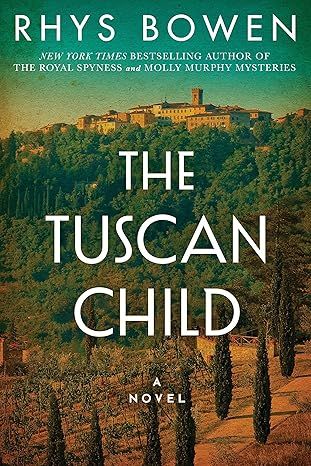
The Tuscan Child
4.2
-
100,022
$8.39
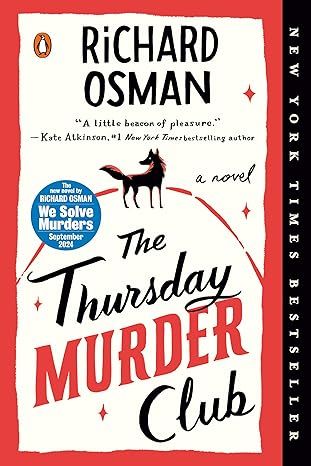
The Thursday Murder Club: A Novel (A Thursday Murder Club Mystery)
4.3
-
155,575
$6.33
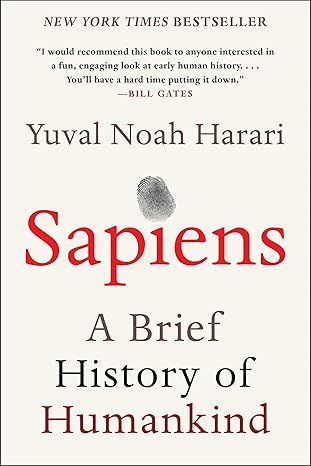
Sapiens: A Brief History of Humankind
4.6
-
140,302
$13.49
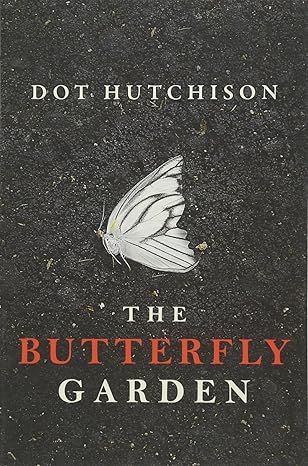
The Butterfly Garden (The Collector, 1)
4.3
-
88,556
$9.59
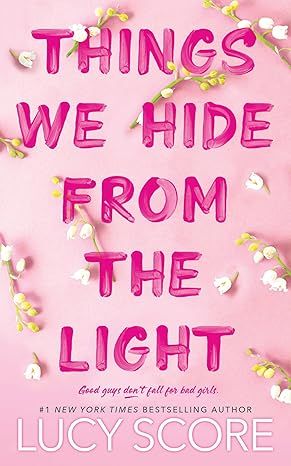
Things We Hide from the Light (Knockemout Series, 2)
4.4
-
94,890
$11.66
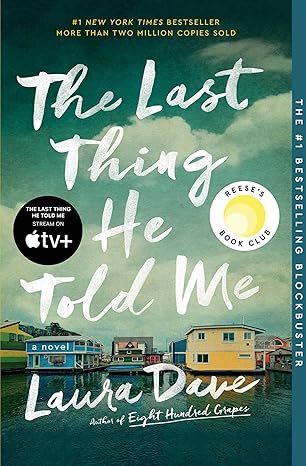
The Last Thing He Told Me: A Novel
4.3
-
154,085
$2.99

The Perfect Marriage: A Completely Gripping Psychological Suspense
4.3
-
143,196
$9.47
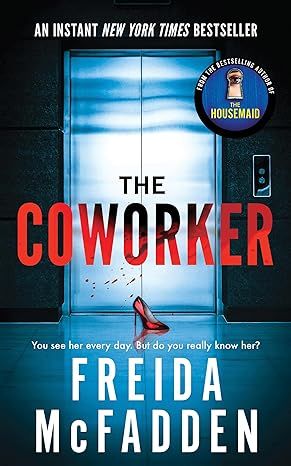
The Coworker
4.1
-
80,003
$13.48

First Lie Wins: A Novel (Random House Large Print)
4.3
-
54,062
$14.99

Mile High (Windy City Series Book 1)
4.4
-
59,745
$16.19

Layla
4.2
-
107,613
$8.99
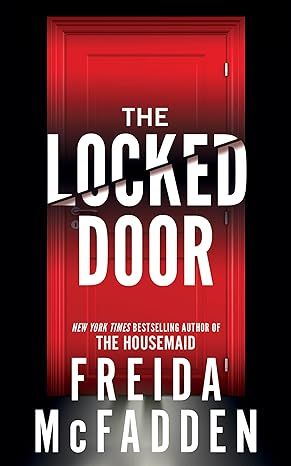
The Locked Door
4.4
-
94,673
$8.53


